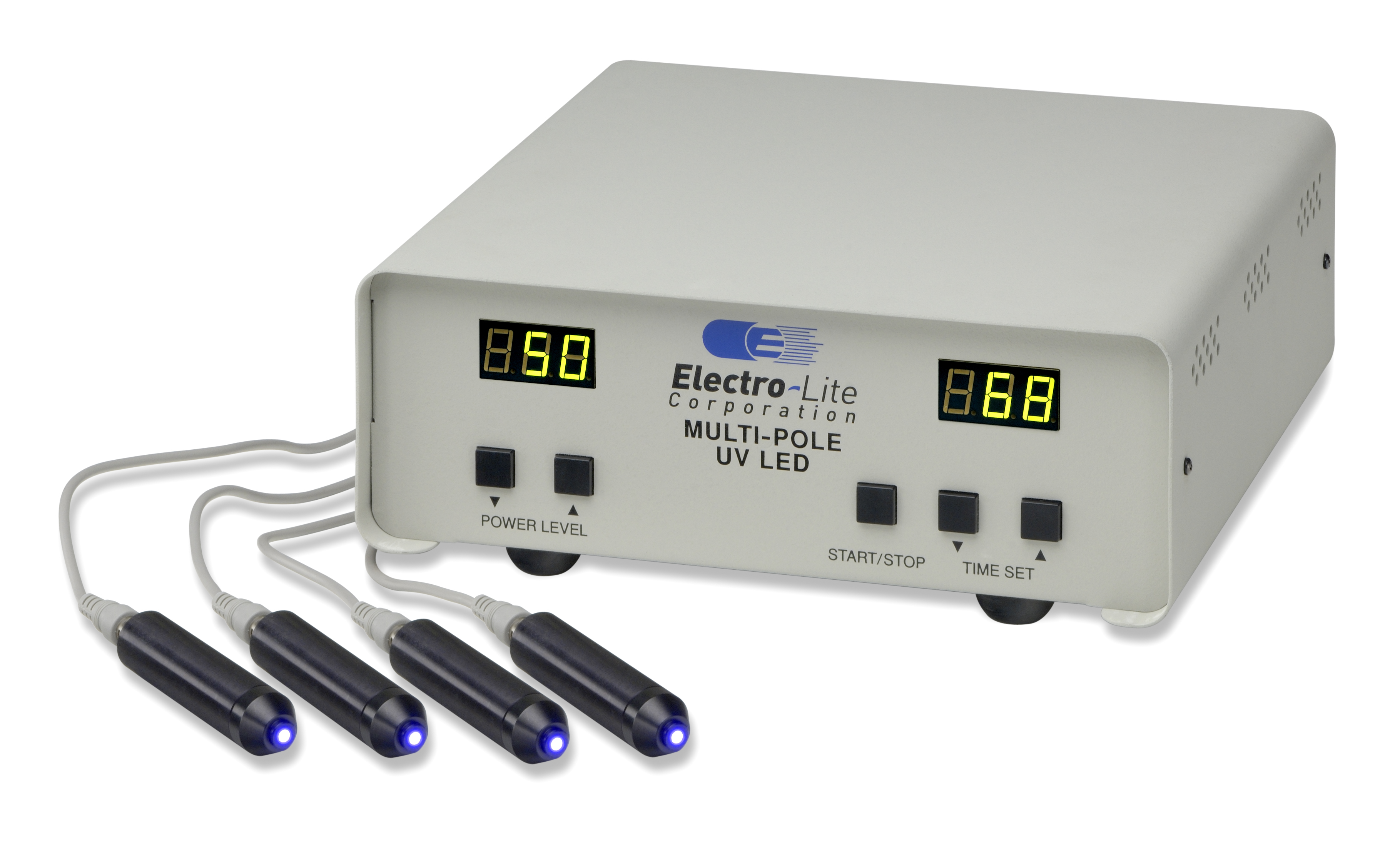Multi-Pole LED UV Curing System

The Multi-Pole LED UV Curing System emits a consistent and repeatable
2.5 W/cm squared @ 365nm at each pole.
Unlike lamp technology there
is no lamp or liquid light guide degradation or UV intensity variables throughout
the
individual poles. The 50,000
hour life of the LED and lack of liquid light guides and replacement lamps
brings to the
forefront of UV technology a
zero level “cost of ownership”! The LED Multi-Pole system is
equivalent to a
10 W/cm squared lamp system using
a 4 pole liquid light guide.
Power input: 120/220V 50/60Hz
UV output: 2.5 W/cm
squared@ 365nm/pole
Controls:
Digital
LED life:
50,000 hrs.
UV set
point: 5% to 100%??
Timer:
1 to 180 seconds in 1 second intervals
On/Off:
Panel/foot
pedal or remote
Dimensions: 9”D
x 10”W x 4”H??
Features:
UV intensity consistent/pole
UV intensity repeatable/pole
Low heat generation
No lamp replacement
No light guide replacement
No cost of ownership
Economical
FEATURE and BENEFIT COMPARISONS
LED TECHNOLOGY vs LAMP TECHNOLOGY
| LED TECHNOLOGY |
LAMP TECHNOLOGY |
No lamp or light guide replacement:
a. No cost of ownership
|
Constant lamp and light guide replacement: a. High cost of ownership |
No fans, no shutters, no moving parts:
b. No maintenance costs
|
Many moving parts:
b. High maintenance costs |
Consistent UV intensity:
c. No parameter shifts
|
Inconsistent UV intensity caused by lamp degradation:
c. Constant parameter shifts
|
Pole to Pole repeatability:
d. 2.5 W/cm2 on each pole with no variation (each pole has it's own power supply)
|
No Pole to Pole repeatability:
d. UV intensity varies from pole to pole |
No fans:
e. No disruption of clean room air flow
|
Fans:
e. Disrupts clean room airflow |
Cure time for Norland UV Adhesive
When bonding two surfaces with Norland UV Adhesive, the minimum full cure is estimated at 20 times the precure time using the same intensity of ultraviolet light. This is a general statement that works well in most applications.
The precure time is defined as the time it takes to initially set or gel the adhesive so that the two surfaces being bonded can no longer be moved. For example, a 15 second precure requires 5 minutes (15 seconds x 20 = 5 minutes) for full cure. Typical precure times will be from 5 seconds to 60 seconds depending on light intensity and adhesive formulation. When different light sources are used in production for the precure and the full cure, the precure time used in this calculation must be measured using the full cure light source.
| Light Source |
Cure Area |
Intensity (microwatts/sq. cm) |
Recommended Distance |
4
Pole Multi-Pole LED |
0.5" diameter |
10,000,000 |
0.5 inches |
Opticure LED |
0.5" diameter |
1,000,000 |
0.5 inches |
|
Opticure 4 |
0.5" diameter |
40,000 |
0.5 inches |
Polylux
500
|
4"x5"x2" |
8,000 |
N/A |
|
Black Lamp |
2" diameter |
14,500 |
6 inches |
|
Black Lamp |
7" diameter |
6,000 |
6 inches |
|
Splice Lamp |
1.5" x 2" |
2,500 |
1.5 inches |
|
Mini Lamp |
5/8" x 4" |
2,000 |
1.5 inches |
|
Bench Lamp |
4" x 15" |
2,000 |
4 inches |
Safety
Ultraviolet light is commonly divided into two regions. Short wave UV in the 190 to 320 nanometer range and long wave UV in the 320 to 400 nanometer range. The short wave UV is considered the most dangerous because it can easily damage the eye and can cause sun burn. No short wave UV light is emitted by any of the Norland UV light sources.
Long wave UV is considered relatively safe. There have been studies that show that high intensity long wave UV and bright visible light up to 500 nanometers can cause damage to the eyes with prolonged exposure. Because Norland UV Adhesives cure so quickly, our UV lights are low to medium intensity and are extremely safe to use with minimal precautions. Do not stare directly at the light and wear UV blocking eye protection. Indirect light from these units is considered relatively harmless.
Home - Adhesives - Fiber Optics - Fish Gel - Distributors - About - Trade Shows - Employment




